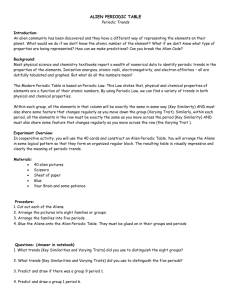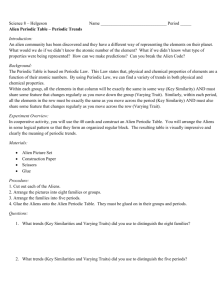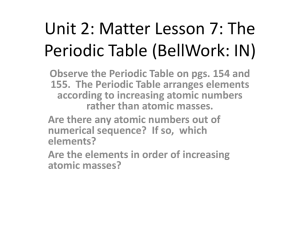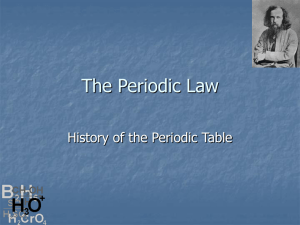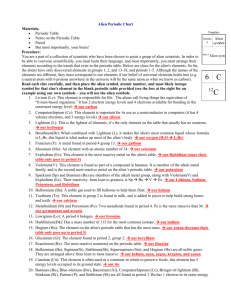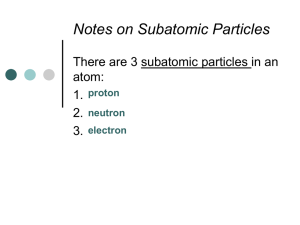Alien Periodic Table: Chemistry Worksheet
advertisement
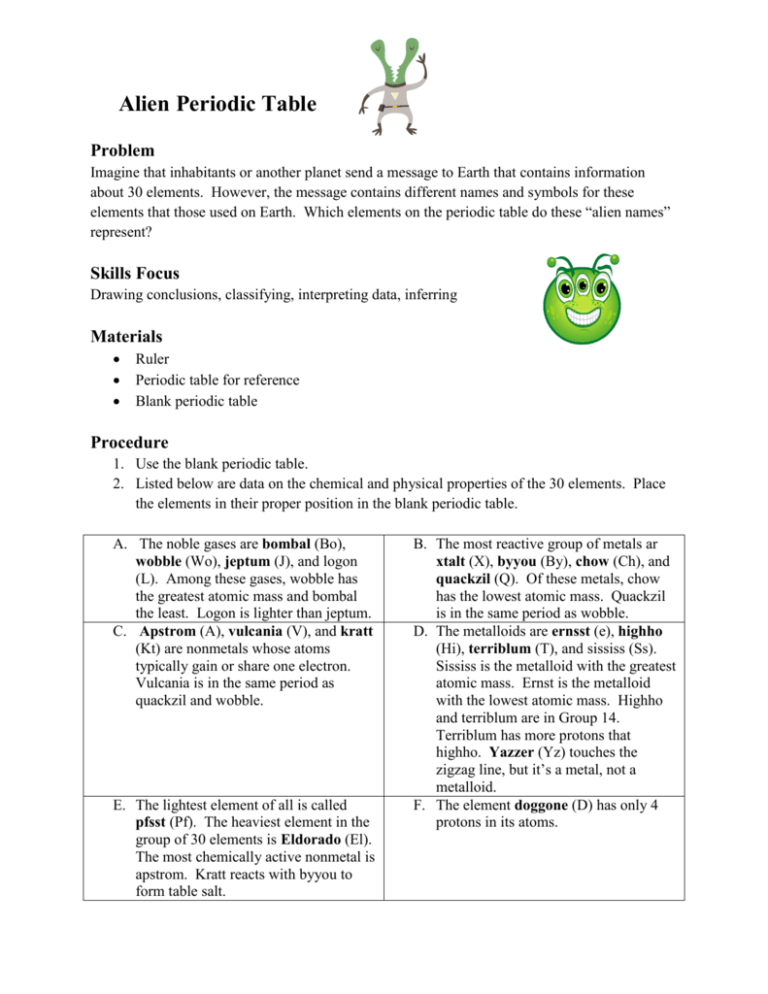
Alien Periodic Table Problem Imagine that inhabitants or another planet send a message to Earth that contains information about 30 elements. However, the message contains different names and symbols for these elements that those used on Earth. Which elements on the periodic table do these “alien names” represent? Skills Focus Drawing conclusions, classifying, interpreting data, inferring Materials Ruler Periodic table for reference Blank periodic table Procedure 1. Use the blank periodic table. 2. Listed below are data on the chemical and physical properties of the 30 elements. Place the elements in their proper position in the blank periodic table. A. The noble gases are bombal (Bo), wobble (Wo), jeptum (J), and logon (L). Among these gases, wobble has the greatest atomic mass and bombal the least. Logon is lighter than jeptum. C. Apstrom (A), vulcania (V), and kratt (Kt) are nonmetals whose atoms typically gain or share one electron. Vulcania is in the same period as quackzil and wobble. E. The lightest element of all is called pfsst (Pf). The heaviest element in the group of 30 elements is Eldorado (El). The most chemically active nonmetal is apstrom. Kratt reacts with byyou to form table salt. B. The most reactive group of metals ar xtalt (X), byyou (By), chow (Ch), and quackzil (Q). Of these metals, chow has the lowest atomic mass. Quackzil is in the same period as wobble. D. The metalloids are ernsst (e), highho (Hi), terriblum (T), and sississ (Ss). Sississ is the metalloid with the greatest atomic mass. Ernst is the metalloid with the lowest atomic mass. Highho and terriblum are in Group 14. Terriblum has more protons that highho. Yazzer (Yz) touches the zigzag line, but it’s a metal, not a metalloid. F. The element doggone (D) has only 4 protons in its atoms. G. Floxxit (Fx) is important in the chemistry of life. It forms compounds made of long chains of atoms. Rhaatrap (R) and doadeer (Do) are metals in the fourth period, but rhaarap is less reactive than doadeer. H. Magnificon (M), goldy (G), and sississ are all members of Group 15. Goldy has fewer electrons than magnificon. I. Urrp (Up), oz (Oz), and Nuutye (Nu) all gain 2 electrons when they react. Nuutye is found as a diatomic molecule and has the same properties as a gas found in Earth’s atmosphere. Oz has a lower atomic number and urrp. J. The element anatom (An) has atoms with a total of 49 electrons. Zapper (Z) and pie (Pi) lose two electrons when they react. Zapper is used to make lightweight alloys. Analyze and Conclude 1. Drawing Conclusions: List the Earth names for the 30 alien elements in order of atomic number. 2. Classifying: Were you able to place some elements within the periodic table with just a single clue? Explain using examples 3. Interpreting Data: Why did you need two or more clues to place other elements? Explain using examples. 4. Inferring: Why could you use clues about atomic mas to place elements, even though the table is now based on atomic numbers? 5. Communicating: Write a paragraph describing which groups of elements are not included in the alien periodic table. Explain whether or not you think it is likely that an alien planet would lack these elements. More to Explore Notice that period 5 is incomplete on the alien periodic table. Create names and symbols for each of the missing elements. Then, compose a series of clues that would allow another student to identify these elements. Make your clues as precise as possible. Teacher Notes Alien Periodic Table Prepare for Inquiry Key Concept In the periodic table, elements are classified according to their properties. Skills Objective After this lab, students will be able to: Draw conclusions about the Earth names of the alien elements based on atomic number. Classify elements based on their properties. Interpret data on the properties of elements. Infer the position of the elements on the periodic table. Prep Time: 5 minutes Class Time: 30 minutes Advance Planning: Remind students to bring their textbooks to lab. Alternate Materials: Give students index cards to rearrange the elements until they find the correct order. Or provide extra copies of the alien periodic table. Guide Inquiry Invitation: Challenge students to find specific elements on the periodic table using clues. Ask: What metal in period 3 is slightly heavier than sodium? (Magnesium) Introduce the Procedure: Refer students to the data for the alien elements and suggest that they work on the clues in order. Emphasize that they will need more than one clue to identify some elements. Troubleshooting the Experiment Suggest that students work in pencil. Allow students to work in pairs. Answer Key Earth Hydrogen Helium Lithium Beryllium Boron Carbon Nitrogen Oxygen Fluorine Neon Sodium Magnesium Aluminum Silicon Phosphorus Alien Planet Pfsst Bombal Chow Doggone Ernsst Floxxit Goldy Nuutye Apstrom Logon Byyou Zapper Yazzer Highho Magnificon Earth (cont.) Sulfur Chlorine Argon Potassium Calcium Gallium Germanium Arsenic Selenium Bromine Krypton Rubidium Strontium Indium Tin Alien Planet (cont.) Oz Kratt Jeptum Quackzil Doadeer Rhaatrap Terriblum Sissies Urrp Vulcania Wobble Xtalt Pie Anatom Eldorado 2. Yes. Some clues identified a c haracteristic belonging to only one element, such as doggone having 4 protons, pffsst being the lightest element, and anatom having 49 electrons. 3. Some clues apply to several elements, such as clues about a group, so you need more information to identify specific elements. 4. Although there are some exceptions to the pattern, the atomic mass of elements usually increases as the atomic number increases. 5. The alien periodic table does not include transition metals, lanthanides, actinides, and elements beyond the atomic number of 50. Sample answer: It is not likely that certain groups of elements would be missing a place where so many other elements are present. More to Explore Sample answer: Democritus (De), boyle (B0, Avogadro (Av), and Heisenberg (Hb) are the names and symbols of the missing elements. Sample clues: all the missing elements are in the fifth period. Hb and Bo are both metalloids, but Hb has a smaller mass. De is an unreactive gas, Av tends to gain one electron when it reacts.

